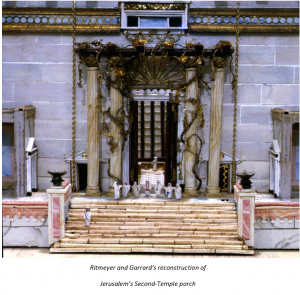Rev’d Peter Balabanski
Easter 5b I am the true vine – John 15 1-8
In John’s Gospel, when Jesus says I am the true vine, or I am the Good Shepherd, or I am the way, the truth and the life, or any of the other I am sayings, the I am part is especially significant. It’s a deliberate echo of God’s revelation of the divine Name to Moses at the burning bush Exodus 3.14 – I am who I am – tell the Israelites that I am has sent you. You might remember in the Good Friday Passion Gospel when soldiers came to arrest Jesus. Jesus asked them who they were looking for. When they said Jesus of Nazareth, Jesus replied literally I am, and everyone fell to the ground. The I am sayings in John’s Gospel tell us that the whole majesty and glory and love of God is present physically in this human being called Jesus.
Often, the I am sayings also make a connection between Jesus’ body and the Temple of Jerusalem. Jesus referred to own body as ‘this Temple’ – a place where God is present John 2.19-22 – which was what the Temple of Jerusalem was for the Jewish people. Jesus called his followers to shift their gaze away from the Temple building, and instead turn to him.
Today’s I am statement, I am the true vine, is for us an obscure Temple reference. What does a vine have to do with the Temple? The archæological architect, Leen Ritmeyer is a world authority on the Temple of Jesus’ time. On the basis of his research, he and a colleague designed and built a scale model of the second Temple Jesus knew. Supporting its porch are four columns. Wreathed up these columns and over the porch is a huge vine, wrought out of gold; the Golden Vine of the Temple.
This vine represented Israel whom God had planted in the Holy Land. Ps 80; Hos 5; Jer 2. It graced the doorway into the Holy of Holies. And pilgrims would bring offerings of golden leaves and clusters of golden grapes to add to the Temple vine’s splendour. In the Mishnah, we read whosoever gave a leaf, or a berry, or a cluster as a freewill-offering…brought it and [the priests] hung it there”. (Middot 3.8) So to return to this morning’s Gospel reading, when Jesus said I am the true vine, he was declaring that he superseded all this in his own person. He was effectively saying, By me, by this doorway, you enter God’s presence. I am the way.
Vines have a mind of their own. Watch them grow and you see creation at work before your eyes. Little tendrils stretch out quickly, looking for the next thing to grab onto. They set the direction of growth for the rest of the vine towards the light. Plants adapt to their environments like that. They adapt and belong – they give fruit, shade, beauty, variety, oxygen – they give life. So I find it a fascinating picture Jesus gives us of ourselves, the church, as the branches. It’s an image which speaks of amazing variety; an image of life-giving providence.
The vine growing in the soil is a picture of Jesus connecting us with the source of our being. It’s an organic, reciprocal image of a church community who can grow and spread where we’re needed in order to provide nourishment, refreshment, shade and beauty. There’s a wonderful purpose to it. Christ as the vine and we as the branches says that we are called to provide for anyone who needs our fruit.
Plants can be utterly different from each other – each specially adapted to its own particular environment. So how does this speak to us – St John’s, a branch of the true vine? In Adelaide terms, we’re an ancient parish – the second oldest – and we’ve seeded other parishes in our time – parishes, a school, St John’s Youth Services, our community store. And we’ve seen significant prunings too. The world around us has changed and we’ve adapted. And Jesus still calls us to bear much fruit. We’re the latest season of branches of the true vine, called to bear much fruit.
 The golden vine of the Jerusalem Temple was a sign of God’s provision, and at the same time, an emblem of the people’s gratitude. It’s a very helpful image, this link between gratitude and generosity. It characterises people who know we are loved and blessed, and feel moved to respond with love and gratitude.
The golden vine of the Jerusalem Temple was a sign of God’s provision, and at the same time, an emblem of the people’s gratitude. It’s a very helpful image, this link between gratitude and generosity. It characterises people who know we are loved and blessed, and feel moved to respond with love and gratitude.
But how to respond to such a gift? In my weekly, I wrote about the work of St John’s Youth Services, which is a beautiful fruit of this branch of the vine. I also wrote about some related services that serve the poorest and most vulnerable in our community – homeless people; people escaping the poison of coercive control and violence; Aboriginal people in need – all on our doorstep, many with no safe place.
It’s time to ask if the fruit we’ve been producing until now is adapted to current needs. Are we bearing enough fruit – the right variety? Are we alive to specific needs; are we willing to be pruned; to have other branches grafted in with us, or to be grafted in different places ourselves? Are we called to something new? These are things we can only discern together through prayer and listening – openly and courageously. Do we increase the ministries we’re doing to meet increased need, or add something quite new? We in Parish Council await your suggestions. Amen.


